#the de nesle sisters
Text





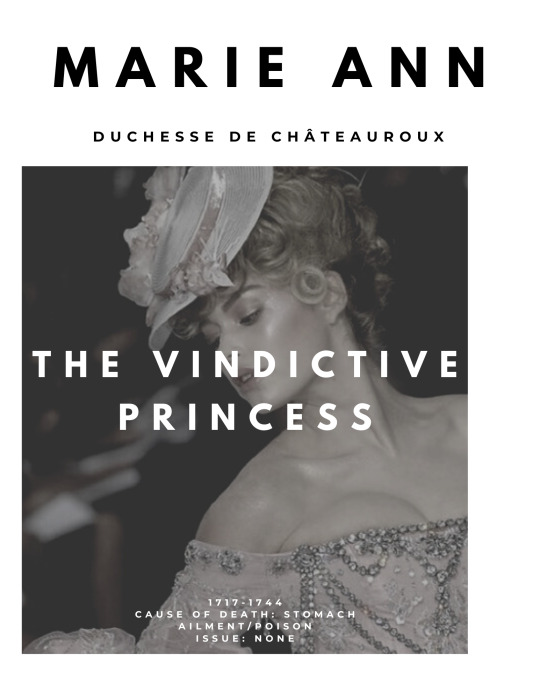
Notorious Women - The de Nesle Women
It is perhaps unsurprising that the daughters of Armande Félice de La Porte Mazarin would go on to live equally infamous lives. Armande was well-known throughout the French aristocracy for challenging the Vicomtesse de Polignac to a duel for daring to sleep with her lover. Of her six daughters, four would go on to become the mistress to Louis XV. Though the sisters were once close in their youth, jealousy would ultimately tear them apart. The tension came to a head when Marie Ann forced the King to banish her sister, Louise, from court. Before retiring to a convent , Louise, was last seen on her knees begging the Louis XV to reconsider. Marie Ann would later face criticism for reportedly forcing her sister, Diane, to participate in three ways with herself and the King.
#historicwomendaily#the de nesle sisters#louis xv of france#french history#women of history#royal mistress#aesthetic#my#my aesthetic post
53 notes
·
View notes
Note
Hi, I'm not very familiar with that era of history and so I wanted to ask: what was Isabella of France's involvement in the Tour de Nesle affair? Was she the one to report it to her father?
Thanks! Love your blog and your edits :)
hi! thank you 💙
Isabelle's involvement in the Tour de Nesle Affair is actually void of any kind of accuracy. The first 'primary' source material that implicates her is from fifty years after the Affair happened, and the retelling of the story itself is pretty much entirely made up, although on this particular point, the author stresses that it's just a rumor going around. The second 'primary' source material directly implicating Isabelle, and goes into a huge amount of details, was written a hundred years after the first source. Mind you, none of the primary sources even agree on the dates of the Affair, with one even straight up switching april for may so that it could rhyme with the next line. So yeah. Accuracy wasn't on the forefront of anybody's mind. What infuriates me is that people still write about it like it's the Truth.
It's true that Isabelle's involvement seems logical, given her trip to France around this exact same time. It's not impossible that she found an angle in which getting rid of her sisters-in-law was profitable for her, her husband, or her son. As Gaëlle Audéon suggests, she could have very well been manipulated by, or found a common interest with Marigny, who himself seems to be the one who profited the most out of the whole debacle. But the evidence is lacking, and the 'sources' implicating Isabelle are not accurate. What could very well be just a coincidence (Isabelle being in France in 1314) shouldn't be considered the absolute, unequivocal truth. Perhaps someone (ahem, Marigny) thought the presence of the Queen of England would be a great distraction to put things in motion.
That being said, i can't stress it enough, but there's not a single cell in my body that will ever believe that any of this 'affair' was true
8 notes
·
View notes
Photo

“Louise de Mailly-Nesle was a major giver for sure. Her nasty, scheming sisters kept taking her advantages, using her to seduce the king and one even banished her from court after giving her false promise. She was hopelessly in love with the king and her naivety really didn't make a good candidate for court life. Sad, she seemed like a nice person who was still kind of her sisters despite what they did to her.” - Submitted by Anonymous
17 notes
·
View notes
Text
Opera Simplified #7: Les Huguenots—Notes, Act IV
** This aria (not including the recitative, which was always kept in) was cut before the premiere. It is now pretty much always reinstated because come on, you’re going to put on a four-hour opera and NOT give the leading lady an aria??? And it’s quite a lovely aria too.
*** de Besme, real name Charles Dianovitz, was an assistant of the Catholic leader Henry I, Duke of Guise. Of Bohemian (as in “present-day Czech”) origin, he is recorded as being the assassin of Admiral Coligny.
**** The Hôtel de Nesle was a mansion on the outer edge of Paris. Built around the Tour de Nesle, a 13th-century guard tower, the Hôtel was torn down in 1665. (There is apparently a currently operational hotel also called the Hôtel de Nesle; presumably there is no connection beyond the name.)
The wedding of Henri de Bourbon, the Huguenot King of Navarre, and Marguérite de Valois, the Catholic Princess of France, took place on August 18, 1572. However, as we all know, royal weddings are not simple affairs but ARE widely and lavishly celebrated. As such, thousands of Catholics and Protestants poured into Paris in the weeks prior to the wedding, leading to rapidly increasing tension between the faiths. In addition, both parties remained in the city for several days afterwards to continue celebrations such as this one.
This would prove fatal.
***** Saint-Germain l’Auxerrois is a Catholic church located directly across from the Louvre Palace, which was the royal palace at the time this opera takes place. And in fact, the bell of Saint-Germain l’Auxerrois was actually the signal for the beginning of the massacre in real life.
****** Known now as the Cross of Lorraine, the Cross of Anjou was a double-barred cross associated with the (Catholic) Valois family. As anyone who has been following the historical part of this Opera Simplified will realize, the dowager royal family consisted of a marriage between King Henri II de Valois and Caterina de Medici, aka Catherine de Médicis, making all their children, including King Charles IX and his sister Marguérite de Valois, descendants of both families.
******* This line is sometimes altered slightly and given to both Raoul and Valentine.
#opera#opera tag#les huguenots#notes#meyerbeer#giacomo meyerbeer#augustin eugène scribe#émile de saint-amand deschamps
1 note
·
View note
Text

Marie-Anne de Nesle, Marchioness of La Tournelle, Duchess of Châteauroux by Jean-Marc Nattier, 1740 / "Dress" by Taylor Swift
#when i say i am obsessed with this painting#that does not even begin to cover it#marie anne de nesle#portrait#jean marc nattier#rococo#art history#dress#taylor swift#reputation#oh to be the girl who takes over being the mistress of louis xv from your older sister#only to die a mysterious early death by possible poisoning#and pass on your mistress duties to your two other sisters#where is her biopic i need it
149 notes
·
View notes
Note
Do you know anything about the Tour de Nesle affair? I heard about it, but there doesn't seem to be much about it online other than the bare essentials.
The Tour de Nesle affair was a scandal involving the daughters in law of Philip IV of France. The story goes that while on a trip home, the daughter of Philip, Isabella of France gifted her sisters in law embroidered purses as a gift. But a year or so later, Isabella noticed that these purses were now in the possession of knights which led her to suspect that they were lovers of her sisters in law. Isabella informed her father and the knights were arrested and tortured for information. Two of the Royal marriages were dissolved, with the children born from the unions declared illegitimate with the third marriage continuing on. The Affair led to a lack of heirs for the French Throne and the opportunity for the English to stake a claim through Isabella's son.
13 notes
·
View notes
Photo

Marie Anne de Mailly-Nesle by Jean-Marc Nattier
Marie Anne de Mailly-Nesle, duchesse de Châteauroux (5 October 1717 – 8 December 1744) was the youngest of the five famous de Nesle sisters, four of whom would become the mistress of King Louis XV of France. She was his mistress from 1742 until 1744.
8 notes
·
View notes
Text
Ser Ryman came stomping up the gallows steps in company with a straw-haired slattern as drunk as he was. Her gown laced up the front, but someone had undone the laces to the navel, so her breasts were spilling out. They were large and heavy, with big brown nipples. On her head a circlet of hammered bronze sat askew, graven with runes and ringed with small black swords. When she saw Jaime, she laughed. “Who in seven hells is this one?”
“The Lord Commander of the Kingsguard,” Jaime returned with cold courtesy. “I might ask the same of you, my lady.”
“Lady? I’m no lady. I’m the queen.”
“My sister will be surprised to hear that.”
“Lord Ryman crowned me his very self.” She gave a shake of her ample hips. “I’m the queen o’ whores.”
No, Jaime thought, my sweet sister holds that title too.
This quote speaks to Jaime’s increasingly negative view of Cersei through AFFC. He has been haunted by Tyrion’s parting words to him - “she's been fucking Lancel and Osmund Kettleblack and Moon Boy for all I know” - and had previously verified that the Lancel part of that statement was in fact true (while seemingly using that verification, as well as his observations of Osmund with Cersei, as proof that the Osmund part was true as well). Now, though, his view on Cersei’s infidelity has turned impersonal. Cersei isn’t just the woman who had sex with two other men besides himself; in Jaime’s mind she’s the “queen of whores”, in a sort of position of supremacy to all other “whores”. It’s a stripping away of any sense of intimacy Cersei may have had in any (non-Jaime) affair, both reducing her to a woman who would bed any man for a price and elevating her to the top of her “field”, so to speak (after all, what would a “queen of whores” be but the greatest, the most experienced, the most popular and successful of “whores”?). Cersei is not different in kind from Ser Ryman’s “slattern”, so Jaime’s thoughts seem to suggest, only in degree: this nameless woman may wear the stolen crown of Robb Stark, but it’s Cersei, with a real (that is, belonging to her as queen and regent) crown on her head, who is the superior “whore” here, giving herself not just to a single drunken Frey but a host of other men.
(I’m reminded of a few lines from The Iron King, after the Tour de Nesle Affair - where, so at least the book describes it, Marguerite of Burgundy, Queen of Navarre carried on an extramarital affair with Philippe d’Aunay - is revealed: “Eight days after the execution of the Aunay brothers and the sentence pronounced upon the Princesses, the people of Paris had already adopted a story in which cruelty, shame and love each played their part. By an unconscious simplification, the whole story centred upon Marguerite of Navarre. No longer was a single lover attributed to her, but ten, fifty.”)
But what do we see with Cersei in the next chapter?
“No.” Osney touched her golden hair. "The thing is, the best lies have some truth in ’em ... to give ’em flavor, as it were. And you want me to go tell how I fucked a queen ...”
She almost slapped his face. Almost. But she had gone too far, and too much was at stake. All I do, I do for Tommen. She turned her head and caught Ser Osney’s hand with her own, kissing his fingers. They were rough and hard, callused from the sword. Robert had hands like that, she thought.
Cersei wrapped her arms about his neck. “I would not want it said I made a liar of you,” she whispered in a husky voice. “Give me an hour, and meet me in my bedchamber.”
“We waited long enough.” He thrust his fingers inside the bodice of her gown and yanked, and the silk parted with a ripping sound so loud that Cersei was afraid that half of the Red Keep must have heard it. “Take off the rest before I tear that too,” he said. “You can keep the crown on. I like you in the crown.”
This is Cersei at some of her lowest in AFFC, Cersei at some of her most pitiable (not ignoring, of course, how many terrible deeds she does in that book). Cersei does not desire Osney Kettleblack, and indeed compares him physically to Robert, her rapist for nearly two decades - and this in the same chapter where Cersei confirmed her hatred of the Blue Bard merely for having the same color eyes as Robert did. This is a sort of replay of her long sexual trauma, and done out of desperation; Cersei genuinely sees no other way to keep herself and Tommen safe but (here, at least) giving in to sex with a rough and violent Robert-esque figure (who, as Robert had, sets the terms of the sex - it happens on his schedule, where he wants it, and proceeds as he decides). Ser Ryman’s nameless slattern seemed to take a sort of joking pride in wearing Robb’s crown - a once-meaningful royal symbol now sitting almost jauntily “askew” on her head, paraded by a nameless lowborn sex worker in a camp of mud and shit - but for Cersei, her real crown - symbol of the actual power she wields, or should wield, as Queen Regent - becomes no more than a way for Osney to objectify Cersei as a sexual conquest, an added bonus for him to the sexual escapade. Far from the image of the “queen o’ whores” as laughing drunkenly in Ryman’s pleasure tent (and that’s really all it can be called, since he’s certainly not prepared for war) and advertising her sexual position with a view of her unlaced top and “a shake of her ample hips”, this is Cersei fighting her own desire to assert herself and instead agreeing to the sexual demands of the man she believes she needs to keep herself and her son safe. Far from the idea of Cersei as the “queen of whores” who would sell herself to anyone, this is a Cersei who is giving in to sex (with only the second man who was not her husband or Jaime) out of a terrible, and terribly sad, conviction that she has no other choice.
(I don’t mean to suggest, to be clear, that the “queen o’ whores” has an easy or pleasant life; as a lowborn female sex worker she has no rights and no security, and even having a client like Ryman Frey doesn’t protect her against his telling her to “[s]hut your mouth” and calling her a “slut”. Since we only see her very briefly, though, it’s hard to the point of impossible to get a reading on her personal view of the situation she is in, whereas with Cersei we’re obviously in her head.)
104 notes
·
View notes
Text
Okay, you know what, I broke down and wrote that essay because I’m having a terrible day at work and need to pick myself up a bit...
Obviously I can’t be in Edmond Rostand’s head, so I can’t be a hundred percent sure of his authorial intent. What I do know is that there’s one character he intended to be both the raisonneur of the play and a little bit of his writer’s bias peeking through… Le Bret. Le Bret, the “sane” one among the cadets, Cyrano’s best friend and the only one who can talk him down from doing anything stupid, who insists that the way to live isn’t through making enemies everywhere you go and posturing about being alone all your life. What’s notable is that his perspective sets him apart from the other Gascony Cadets, a hotheaded bunch who fight anybody who insults them and look forward to dying heroic deaths in battle. It can very easily be argued that they value that eventual death more than they value their current lives. And it’s part of the reason they hate Comte de Guiche so much--he dares to live like he actually has a future, refusing to burn his bridges for his own funeral pyre as he goes.
Of course, this doesn’t apply so much when they’re starving and miserable during a siege… suddenly dying in battle doesn’t sound so glamorous.
But where does this leave Cyrano? Well, he doesn’t necessarily disagree—he certainly gets into enough fights over the course of the play, and he says at one point that he’d be happy to die with “honorable steel piercing (his) heart and a piercing epigram upon (his) lips.” He expounds upon his desire to be alone and independent in the famous “no, thank you” speech. But while his lifestyle doesn’t sound like it would lend him toward having many friends… he still has quite a few. He still has Le Bret, his greatest confidante. He still has Ragueneau, whom he admires for his poetic spirit and kind heart. He still has the cadets, his brothers-in-arms. And of course, he has Roxanne and Christian, the former he’s loved all his life and the latter he comes to care for over the course of the play. More than that, as abrasive and proud as Cyrano can be, he’s also unfailingly kind to the downtrodden of Paris, saving his ire for the rich fat cats who want to absorb them into their cliques rather than let them live individual lives. He pays back the theatergoers In full after closing the play, he kisses the hand of a banquet girl to thank her for her offer of a free dinner (she overheard that he was penniless and wanted to help, but he couldn’t bear to accept charity at her expense), and he invites the other actors and ushers to come with him as safe spectators at the Port du Nesle. He even affectionately teases the Sisters at the convent where Roxanne is living in the last act, making them laugh and keeping them company. He didn’t have to give any of them the time of day, and yet he did. He can insist he doesn’t care all he wants, but at the end of the day, he does. He cares quite a bit. He cares enough about Christian and Roxanne, at least, to survive the Siege of Arras and remain both her friend and a living testament to his memory.
The downside to all of it is that Cyrano is also a miserable, self-sabotaging man who doesn’t seem to value his life at all and constantly stands in the way of his own success. In his own mind, he’s no hero--he can only pretend to be one and hope it sticks. His self-esteem is already in the dirt because of his appearance (and the implied neglect he suffered as a child because of it), so to have it drilled into his head that all that’s left for him is a good death doesn’t help. This lifestyle is all he knows... and it’s what he manages to circle back to every time, no matter who tries to talk him out of it or how much it affects his relationships. It’s a classic Tragic Hero setup, but Cyrano refuses to see himself that way, and woe betide anyone who tries to smack a label on him.
At the end, Cyrano’s death isn’t a noble last stand, much as he tries to make it into one at the last second. It’s a senseless, meaningless tragic accident. And it comes right on the cusp of Roxanne realizing how he truly felt about her all this time. They might have been able to have a longer conversation about it and even been happy together, but it’s cruelly interrupted by Cyrano’s fatal injury. It comes to prove that the way someone dies doesn’t matter—we all end up in the dirt somehow, it’s just a matter of different routes. It’s how someone lives that matters. Before he dies, he asks that Roxanne remember him (but never to stop mourning Christian), fights off visions of his own character flaws, and insists that one thing will remain after he’s gone… his white plume. His panache. His visible soul. He wants to have lived a life that truly mattered, that will never be forgotten. And he’s not alone—he has Roxanne, Ragueneau, and Le Bret there to catch him when he finally falls.
Dying is easy. Living is harder, but so much more worthwhile. The real tragedy is that it took Cyrano five acts and fifteen years to learn that.
#cyrano de bergerac#the schemer speaks#If only I could have written this during my actual styles class in college... XD#Honestly something that always gets overlooked in analyses of Cyrano's character is that he manages to be a *genuinely good person*#in a culture that doesn't reward genuinely good people.#If you're constantly preparing to die you're not going to bother treating anyone decently because in your mind it doesn't matter.#Cyrano can't bring himself to burn so many bridges and that's what saves him from dying alone in a gutter.#He's not a *nice* person to be sure but if 'Into the Woods' taught us anything it's that 'nice' is different than 'good.'#He's a disaster man but he's my disaster man. <3
4 notes
·
View notes
Photo


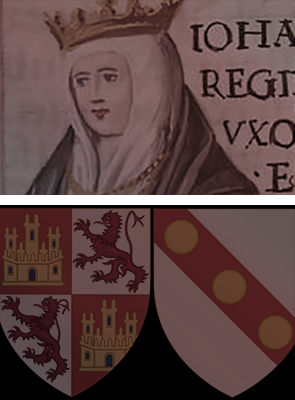

WOMEN’S HISTORY † JEHANNE DE DAMMARTIN (c. 1220 – 16 March 1279)
Jehanne de Dammartin was the eldest of the four daughters of Simon de Dammartin, comte d’Aumale and Marie, comtesse de Ponthieu, daughter of Guillaume IV de Ponthieu and Alix de France, comtesse du Vexin. Her parents’ marriage had been arranged by Philippe II de France as Simon was the younger brother of Philippe’s childhood friend, Renaud de Dammartin, who had also abducted Ide, comtesse de Boulogne with the king’s consent. In 1214, however, her father and uncle had abandoned Philippe to ally themselves with John I of England where they fought against him at the Battle of Bouvines. After the defeat of John’s army, Renaud was imprisoned and Simon was exiled. After Philippe’s death, Simon was allowed to return by Louis VIII under the condition that he not enter Ponthieu or negotiate the marriage of his daughters without royal permission.
Nevertheless, in 1234, Simon secretly negotiated that Jehanne would marry Henry III of England, the eldest son of John Lackland and Isabelle d’Angoulême. Louis VIII’s widow, Blanca de Castilla, who was acting as regent in the time of her son, Louis IX, caught word of this plan and told Simon that he would be stripped of all his lands if he allowed the marriage of Jehanne to Henry and petitioned the Pope to block the marriage on the grounds of consanguinity. Henry agreed to abandon the plan and instead married Alienòr de Provença.
Meanwhile, it was instead arranged that Jehanne would marry Fernando III de Castilla, the son of Blanca’s sister, Berenguela de Castilla and widower of Elisabeth von Schwaben. Jehanne and Fernando married in October of 1237 and they had four sons, two of whom died young, and a daughter. Little is known about Jehanne’s tenure as queen of Castilla and Leon other than that she accompanied Fernando during his siege of Seville in 1248. Her mother, Marie, died in 1251 and Jehanne succeeded her as the comtesse de Ponthieu. Fernando died 30 May 1252 and was succeeded by his eldest surviving son by his first wife, Alfonso X.
Before his death, Fernando had asserted a claim to Gascony as the great-grandson of Eleanor of England and Alfonso also retained that claim. In the end, the matter was resolved when it was arranged that Jehanne’s only daughter, Leonor de Castilla, would marry Henry III’s eldest son and heir, the future Edward I, on 1 November 1254. Jehanne had a tense relationship with her stepson, Alfonso, and allied with another stepson, Enrique, which led to Jehanne and her eldest son, Fernando, leaving Spain entirely to take up residence in Ponthieu.
At some point before 9 February 1261, Jehanne remarried to Jehan de Nesle, seigneur de Falvy. Her cousin, Mathilde de Dammartin, died in January 1259 with her two children having pre-deceased her, so the title of comtesse d’Aumale passed to Jehanne. Jehanne also asserted a claim to Boulogne, but that instead went to Adelheid van Brabant, daughter of Hendrik I van Brabant and Mathilde de Boulogne, the younger of the two daughters of Mathieu d’Alsace and Marie Ire de Boulogne. Jehanne’s rule as comtesse de Ponthieu was marked mostly by lavish spending and little attention to her political duties. Between 1274 and 1278, she looked after her granddaughter, Joan of Acre.
Jehanne died 16 March 1279 and disputes arose. Her daughter, Leonor and grandson, Jehan de Ponthieu, both claimed Aumale and Ponthieu, but in the end, Aumale passed to Jehan while Leonor got Ponthieu. Leonor and her husband, Edward I, were more attentive to their duties than Jehanne was and were quick to pay off the numerous debts she’d accrued. After Leonor’s death, Ponthieu passed to only surviving son, Edward II, and then his son, Edward III, but was confiscated in 1336 by Philippe VI de France due to Edward’s sheltering of Robert III d’Artois, which was one of the many factors leading to the Hundred Years’ War. As for Jehan de Ponthieu, he went on to die at the Battle of the Golden Spurs in 1302. His granddaughter, Blanche d’Aumale, married Jehan III d’Harcourt, and her great-granddaughter, Marie d’Harcourt, was the mother of Ferry II de Vaudémont, the husband of Yolande d’Anjou.
#joan of dammartin#house of ivrea#medieval#french history#spanish history#european history#women's history#history#women's history graphics#nanshe's graphics
35 notes
·
View notes
Text
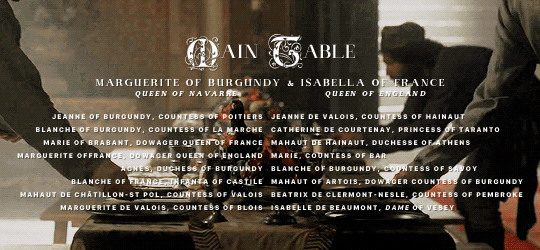


The ladies-only banquet was one of many events organized in the days that immediately followed the ceremony held on June, 5th 1313, where the three sons of the King of France Philippe IV, along with some 200 noble young men from the most prestigious families in the kingdom, were officially knighted.
At the second table, were seated: Yolande of Dreux, Dowager Duchess of Brittany, her sister-in-law Pernelle de Sully, the Dowager Countess of Dreux, her mother Marguerite de Beaumez, Blanche of Brittany, sister of Mahaut of Artois, Jeanne of and Marie of Artois, her daughters, Isabelle de Rumigny, Dowager Duchess of Lorraine, Elisabeth of Austria, Duchess of Lorraine and daughter of Emperor Albert I; the cousins of Marguerite of Burgundy Marie of Hainaut, Jeanne d'Argies, Countess of Soissons, perhaps Béatrice, Princess of Hungary and Dauphine of Viennois, Marie of Flander, Countess of Boulogne, Isabelle of Lorraine, Countess of Vaudémont, Agnès de Brienne, Countess of Joigny, her daughter Jeanne of Joigny, Eleonore of Savoy, Countess of Forez, Louise de Beaumetz, Countess of Sancerre, Marie, Countess of Roussis, Jeanne de Gîgne, Countess of Eu, perhaps Béatrice of Burgundy, Dowager Countess of La Marche, Marguerite of Burgundy's aunt, Isabeau de Coucy, sister of Mahaut de Châtillon-Saint Pol; the ladies of Jeanne of Burgundy: Alix de Joinville, lady of Beaufort, wife of John of Lancaster, Alix de Clermont-Nesle, lady of Nesle, Jeanne de Tancarville, Vicountess of Melun, Isabelle de Forez, wife of the governor of Lyon, Jeanne de Dampierre, Jeanne de Vendôme.
A third table was counting at least: Marie de Vaucemain, lady of Chey, a lady of Marguerite's, Alips de Mons, wife of Enguerrand de Marigny, Roberte de Beaumetz, her daughter-in-law and a cousin of the Countess of Sancerre, Jeanne de Machot, lady of Viarmes, daughter of Saint Louis' chamberlain and the wife of Philippe IV's chamberlain, Marguerite des Bars, wife of another chamberlain of Philippe IV's, Isabeau of Burgundy, wife of a chamberlain of Louis, King of Navarre, Isabeau de Rosny, her mother-in-law, Marguerite de la Roüe, Jeanne de Courpalay and Béatrix, widow of Nogaret. Wives of other clerks were also in attendance, potentially along female members of the bourgeoisie. — Gaëlle Audéont, Philippe le Bel et l'Affaire des Brus, 1314
310 notes
·
View notes
Photo

“I love Marie Antoinette and Louis XVI but I wish more people would write about Louis XV's court! There was so much drama!! Madame de Pompadour, Madame du Barry, all the Nesle sisters... we need a TV series about them!” - Submitted by Anonymous
46 notes
·
View notes
Photo

The five de Mailly-Nesle sisters were beauties at the court of King Louis XV of France and four of the five sisters became Louis' mistress at various points in his early life. Their maternal great-grandmother had been Hortense Mancini, a great beauty (along with her own sisters) at the French and English courts of the late 17th century and a mistress of Charles II of England. Here, from left to right, we see Marie-Anne, Diane-Adelaide, Louise-Julie (Louis XV's first ever official mistress) and Pauline. The sister who did not become Louis' mistress was Hortense-Félicité. I particularly love Diane and Marie-Anne because of their round, chubby faces. I wish that was still in vogue! 🌹
13 notes
·
View notes
Photo

Today in history, April 29, 1326: the death of Blanche of Burgundy:
"Blanche of Burgundy (c. 1296 – 29 April 1326) was Queen of France and Navarre for a few months in 1322 through her marriage to King Charles IV the Fair. The daughter of Count Otto IV of Burgundy and Countess Mahaut of Artois, she was led to a disastrous marriage by her mother's ambition. Eight years before her husband's accession to the thrones, Blanche was arrested and found guilty of adultery with a Norman knight. Her sister-in-law, Margaret of Burgundy, suffered the same fate, while her sister Joan was acquitted. Blanche was imprisoned until she became queen, when she was moved to the coast of Normandy. The date and place of her death are unknown; the mere fact that she died was simply mentioned on the occasion of her husband's third marriage in April 1326.
Blanche was the younger daughter of Otto IV, Count of Burgundy, and Mahaut, Countess of Artois. Her father died in 1302, leaving the county to Blanche's younger brother, Count Robert. Blanche's elder sister Joan was supposed to marry King Louis the Headstrong of Navarre, the eldest son and heir apparent of King Philip the Fair of France, but Philip the Fair changed his mind and arranged for her to marry his second son, Count Philip the Tall of Poitiers, in 1307. The same year, Louis married Margaret of Burgundy. The Countess of Artois was proud of this achievement and quickly started negotiating her younger daughter's marriage to Count Charles the Fair of la Marche, King Philip's third son, offering a huge dowry. The negotiations were successful and on 23 September 1307, the eleven-year-old Blanche and two years older Charles concluded a marriage contract. The marriage ceremony was hastily performed at Countess Mahaut's castle in Hesdin in January 1308. At first, the Count and Countess of la Marche had an unremarkable marriage that was neither as flawed as that of the King and Queen of Navarre nor as harmonious as that of the Count and Countess of Poitiers.
In 1313, the Countess of la Marche's sister-in-law and brother-in-law, Queen Isabella and King Edward II of England, paid a visit to King Philip. Isabella presented her brothers and sisters-in-law with embroidered coin purses. Later that year, upon their return to London, Isabella and Edward held a banquet during which the Queen noticed that the coin purses she had given to Blanche and Margaret were now in the possession of the Norman knights Gautier and Philippe d'Aunay. From that she concluded that the brothers were having relationships with her sisters-in-law. When she visited Paris again in 1314, she informed King Philip about her suspicions.
Blanche and Margaret were soon accused of inappropriate conduct, such as drinking and eating with the knights, and of eventually committing adultery with them in Paris guard tower known as the Tour de Nesle. Blanche's sister Joan was accused of hiding the affair and later of participating in it.
The accusations against Countess Blanche and Queen Margaret were more than likely true, but several 14th-century chroniclers believed that their father-in-law's popularly despised chamberlain Enguerrand de Marigny might have falsely incriminated them and the knights.
After a certain period of time, King Philip ordered the arrest of all his daughters-in-law and the knights. Following torture, the knights confessed to adultery and admitted that it had lasted three years. The Countess of la Marche and the Queen of Navarre were tried before the Paris Parlement and were found guilty of adultery. Their heads were shaven and both were sentenced to life imprisonment underground in Château Gaillard, while their lovers were condemned to death and duly executed. Her first child, a son named Philip, was born around 5 January 1314 and thus before the accusation of adultery levelled at his mother, so presumably his paternity was not challenged; her second child, a daughter named Joan, was born in 1315 after the trial, so some doubt about her paternity was suggested by the contemporary Continuatio of the Chronicle of Guillaume de Nangis, moreover because reportedly Blanche became pregnant either by one of her jailers or by her own husband ("a serviente quodam eius custodiæ deputato dicebatur...a proprio [comite] diceretur"); however, she was presumably accepted as part of the royal family according to later sources. Despite her disgrace, Blanche remained in contact with her ambitious mother and often received gifts from her.
King Philip, severely shocked by the scandal, died within a year. Margaret, now queen of France, died imprisoned soon thereafter, probably murdered. Louis's reign was cut short by his sudden death. Soon, Philip the Tall and Blanche's sister Joan became king and queen of France and Navarre. It was suggested that Blanche was treated better once her sister became queen, but that was concluded from a single misinterpreted document and may not be entirely accurate. Queen Joan did, however, arrange for her youngest daughter Blanche to become a nun, hoping that the seven-year-old's cloistered life would atone for her sister's transgression
Pope John XXII annulling the marriage of Charles the Fair and Blanche of Burgundy
On Philip the Tall's death on 3 January 1322, Blanche's husband inherited the crowns. Blanche thus became queen of France and Navarre, but her husband still refused to release her. Both of her children died in infancy, Philip before 24 March 1322 and Joan on 17 May 1321. Charles requested annulment of their marriage, to which Blanche reluctantly agreed. The annulment was justified by the claim that Blanche's mother was Charles's godmother, although probably the real reason was Blanche's pregnancy during her imprisonment. Pope John XXII declared their marriage null and void on 19 May 1322, and gave both Charles and Blanche permission to remarry. The Countess of Artois requested, among other things, the return of her daughter's enormous dowry.
Though she was replaced immediately by Marie of Luxembourg, there was no hope for Blanche to remarry, as she was sent to Gavray Castle. There is no evidence that supports the common belief that she died as a nun at Maubuisson Abbey. Having spent eight years imprisoned underground, the former queen suffered from poor health. The date of her eventual death is unknown; the Pope mentioned her as dead in a document of 5 April 1326 issuing a dispensation for the marriage of her former husband and Jeanne d'Évreux."
8 notes
·
View notes
Photo



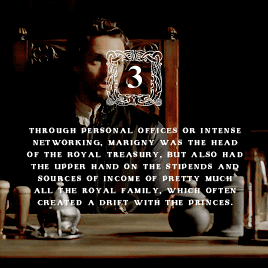





Proving the innocence of Marguerite, Jeanne and Blanche of Burgundy in the Tour de Nesle Affair, based on Gaëlle Audéon’s work, Philippe Le Bel et l’Affaire des Brus, 1314, Nouvelle enquête sur une affaire d’Etat, ou pourquoi les femmes n’ont jamais régné en France (2020)
By framing Marguerite of Burgundy and her sisters-in-law/cousins, Jeanne and Blanche of Burgundy, for an imaginary crime, Marigny was presenting their three husbands, Louis, King of Navarre, Philippe, Count of Poitiers and Charles, Count de La Marche, as incompetent, naive and in a much larger measure, unfit to rule. He successfully diverted the attention away from the Crusade, avoided bankruptcy, steadily isolated the King by driving a wedge with the House of Burgundy (the Count being Marguerite’s brother), nipped in the bud any hypothetical rivalry to come with the future Queen Consort, and refocused the debate onto the ‘Flanders issue’, thus reaffirming his position as the almighty advisor at the expense of the Princes and the Barons.
As for Isabella of France’s possible involvement, Gaëlle Audéon suggests that, if she was involved at all (being then on a diplomatic trip to France, which brought her together with her family on a regular basis in the days leading up to the event), it is very possible that she was manipulated by Marigny as well. Her father’s advisor was already a valuable member of the government when she was born in 1295, owing his position to Isabella’s late mother, Jeanne of Navarre, with whom he was brought up. On various occasions Marigny was sent to England as an ambassador, thus a familiar face for Isabella to hold onto, and it’s very likely that it is through these trips across the Channel and thanks to detailed accounts on the English court by Marigny that Philippe IV was able to take measures in order to ensure Isabella’s comfort when her husband was favouring Gaveston openly at the expense of his daughter. If, and only if, Isabella was involved in her sisters-in-law’s misfortune, her role would have certainly not been to expose them out of personal revenge, as Audéon notes, but rather that she possibly offered to break the news, which she held from Marigny (whom she obviously thought was a reliable source), to her father the King. Another hypothesis is that she was simply told by her father only a few hours before the three princesses were arrested.
Lastly, it was Marigny who, in November 1314 (barely six months after the ‘Affaire’ broke out), enforced a new law that rejected the daughters from the Poitiers succession, when Philippe IV was dying. This new rule would eventually, decades later, lead to the Salic Law preventing the Filles de France from inheriting the French throne. That the King’s principal advisor would take such a drastic measure while his King is laying unresponsive (Philippe IV was comatose, since a hunting accident the day before) is definitely a testament to his cynicism, notes Audéon, and that the man was very much capable of the worst if it came down to it.
#historyedit#marguerite de bourgogne#jeanne de bourgogne#blanche de bourgogne#mine#*#14th century#yes i read this book in less than 24h#no i'm not feeling well#they deserved so much better i'm so sad :(
243 notes
·
View notes
Photo
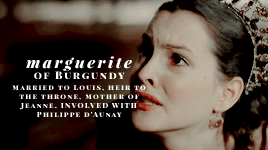









history meme (french edition) → 8 moments (3/8) the scandalous Tour de Nesle Affair (1314)
“They called it the affair of the Tour de Nesle, for it was in that tower in Paris, on the banks of the Seine, that Marguerite and Blanche of Burgundy had been wining, dining, and carrying on adulterous affairs with the brothers d’Aulnay; their sister-in-law, Jeanne, had been a witness and had pleaded with them to desist but had not thought fit to reveal their treason. As we have seen, Isabella had already been nursing her own concerns about these young people; according to the chronicles, prompted by her observation of their suspicious behavior, she now informed her father of what she had seen the year before [...]. All were arrested. After merciless torture, the d’Aulnay brothers confessed to their crimes and were condemned to death. In a trial held in camera before the Paris Parlement in April, Marguerite and Blanche also admitted their guilt [and] were sentenced to life imprisonment. Marguerite’s marriage to Louis of Navarre was immediately annulled; it had never been very happy [...] so it was not surprising that she had looked elsewhere for love. Now, weeping constantly with remorse, she was made to wear the cowled garb of a penitent, and her hair was symbolically shorn; then she was shut up in a dark, damp dungeon in Château Gaillard in Normandy, a grim fortress built in the late twelfth century by Richard the Lion-Hearted; here, she appears to have been subjected to a regime of systematic ill-treatment [...]. Blanche of Burgundy also had her head shaved and was immured in Château Gaillard, in a cell below ground, yet despite the pleas of her husband, Charles, the Pope refused to annul their marriage. [...] The unfortunate d’Aulnay brothers fared far worse: after being publicly castrated, with their genitals thrown to the dogs, they were partially flayed alive before being broken on the wheel and then mercifully decapitated at Montfaucon in Paris; afterward, their broken bodies were displayed on gibbets.” – A. Weir, Queen Isabella.
#historyedit#historymeme#mine#*#marguerite of burgundy#blanche of burgundy#philip the fair#tw gore#tw blood#tw death#long post
335 notes
·
View notes